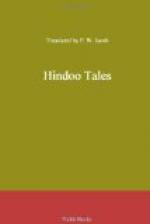Rajahansa, king of Magadha, father of Rajavahana,
the hero of the
story.
Rakshas or Rakshasas, evil spirits or
ogres, hostile to men, whom
they used to devour.
Rati, a goddess, wife of Kama.
Rishi, nearly the same as Muni, a holy man
retired from the world,
devoted to prayer and meditation.
Satyavarma, son of a minister of Rajahansa, and father of Somadatta.
Savara, fem. Savari, a savage, not a Hindoo.
Siddha (literally perfected), a very holy devotee.
Simanta, a religious ceremony performed on
behalf of a woman at a
certain period of pregnancy.
Sinhaghosha, the deposed King of Benares.
Sinhavarma, King of Anga, father of Ambalika.
Sitavarma, one of Rajahansa’s ministers.
Sringalika, the nurse of Ragamanjari.
Siva, one of the three chief gods or triad
of the Hindoos, Brahma,
Siva, and Vishnu, who are sometimes regarded
as one, sometimes
confounded with each other.
Sumantra, son of Dharmapala.
Susruta, son of Padmodbhava.
Taravali, a Yaksha lady, wife of Kamapala.
Vamadeva, a holy man consulted by Rajahansa.
Vamalochana, daughter of Viraketu, wife of Somadatta.
Vasumati, Queen of Rajahansa.
Vasundhara, Queen of Anantavarma the King of Vidarba.
Vidarba, name of a country.
Videha, a country called also Mithila.
Vidyadhara, one of the numerous demigods.
Vidyeswara, the conjuror who married Rajavahana to Avantisundari.
Vikatavarma, King of Mithila, husband of Kalpasundari.
Vimardaka, a keeper of a gaming house, employed by Apaharavarma.
Viraketu, King of Patali, father of Vamalochana.
Yaksha, a sort of demigod or fairy, a servant of Kuvera.
Yama, God and Judge of the Infernal Regions.
Yati, an ascetic, a devotee.
Yavana, a Greek, an Arabian—any foreigner.
THE END.
* * * * *
FOOTNOTES:
[Footnote 1: A religious ceremony on behalf of a woman at a certain period of pregnancy.]
[Footnote 2: The Hindoos attach much importance to certain marks on the body, such as the lines on the hands, &c.]
[Footnote 3: Kusa-grass, or kuskus, is used for strewing the floor of a sacrificial enclosure, for laying offerings on, and for other sacred uses.]
[Footnote 4: To be pushed in through opening in a wall, so as to receive any blow which might be given.]




